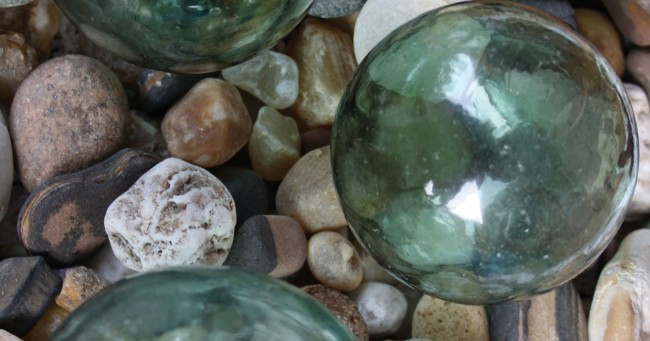
Photo Credit: Norma Kerby
Glass Fishing Floats: Vintage treasures from the Westerlies
My aunt almost married a North Coast fisherman. The romance between the pretty young teacher and the tall Norwegian fell casualty to family objections and World War II, but the story, like the jade-coloured glass fishing floats which sat in my grandmother’s kitchen window, did not fade away.
As a child, I was fascinated by these sea-green glass balls, lit in the evening sun. I resolved that one day I too would travel to the exotic Queen Charlotte Islands and collect treasures on the beach and meet a handsome prince who would whisk me away in his fishing boat.
I never did meet the prince, but the lure of miles of sandy beaches on Haida Gwaii have drawn me back almost every summer, searching for gifts from the sea. In the salty banquet of scallop wings, moon-snail shells, agates and Russian light bulbs, glass fishing floats are the ultimate prize for beachcombers on the west coast of North America. Tossed up by autumn storms into the beach-grass dunes, perched precariously atop breaker-washed boulders, glinting seductively through rotting kelp, these unique glass balls attract collectors from around the world.
Glass fishing floats have an interesting history. Prior to their introduction to the fishing industry, wood or cork fishing floats were used to keep netting strung across the surface of the water. I can remember as a child picking up hand-carved cedar wood floats along the banks of the Skeena River, escapees from historic salmon netting activities at villages upriver.
Wood, though, can become water-logged and, in salt water, floats can be drilled full of Toledo worm holes. In 1842, an enterprising Norwegian inventor, Christopher Faye, and the Norwegian glass company, Hadeland Glassverk, came up with a hollow glass float specifically designed for deep-sea fisheries. Glass is durable, light-weight, and lasts almost forever in marine environments. The hand-blown Norwegian glass floats, wrapped in strong netting, rapidly became the standard for the European fishing industry.
Introduced into Asia by expanding European trade and colonialism, glass fishing floats became an important trade item during the Victorian era. With the industrialization of countries such as China and Japan, by the early 1900s glass floats were being manufactured in the Far East. In Japan, their manufacture had begun by at least 1910 and continued until the 1970s, when plastic, aluminum, and Styrofoam floats largely replaced glass. Over sixty years of intensive use, millions of glass floats, ranging from 5 cm to over 90 cm in diameter, were used to support vast webs of nets and longlines spread throughout the North Pacific. It is from this historic supply that most of the glass floats on the beaches of Haida Gwaii are derived.
Handblown glass
How do you know if you have an authentic antique or vintage glass fishing float? Japanese glass fishing floats are distinctive. Made from thick, handblown glass full of bubbles, they characteristically have a plug or button of glass at the bottom where the blowpipe was pulled out. If you are fortunate, you may find a float with a trademark in Japanese script next to the glass plug. For example, one of the biggest glass-float manufacturers in Japan, the Hokuyo Glass Company, had a trademark which looked like a double ‘f’.
Colour is another important characteristic of authentic floats. As the thickness of the glass and not the quality of the glass was important, most floats were made from recycled glass such as sake bottles, which were blue to sea-green in colour. The majority of vintage Japanese glass floats are also this colour. Only rarely were red glass (caused by small amounts of gold in the glass) and amber glass used.
Most of the brightly coloured glass fishing floats available on Internet sites today, ranging from bright reds, neon greens, cobalt blues and brilliant yellows, are modern replicas made for the tourism and collector markets. Signs that a glass fishing float is a replica include thin glass clear of bubbles and a lack of beach erosion and scrape marks.
The shape of traditional Japanese glass floats also varied, depending upon use in the long, open-ocean fishing nets. Most glass floats were hollow globes. ‘Round’ fishing floats ranged from baseball-sized to giant balls bigger than baskets. Compared to the small floats, though, these larger floats were often blown into wooden or metal molds and show raised seams on the surface of the ball. Round was the most common shape, but occasionally cylindrical floats shaped like rolling pins, sausages and dual floats are also found.
Over time, millions of these glass fishing floats broke loose when nets were damaged during fall and winter storms. Prevailing ocean currents and blustery Westerly winds moved the floats eastward across the ocean. It takes an estimated seven to ten years for a fishing float to reach BC from the coast of Japan. As the majority of authentic glass floats are now over fifty years old, floats washing up on the western shores of North America today mostly come from the large numbers that were trapped in the gyre of currents in the North Pacific. It takes a major storm to move glass floats from this gyre onto the Haida Gwaii coastline.
Collectors’ items
When glass floats, attractive and unusual, do wash ashore, they have long been considered prized collectors’ items. A search of on-line auction sites shows the high amounts paid for them. A 90-cm diameter ball might sell for more than $160, and 10-cm balls for $6 to $20 each.
Collectors can be very competitive. One day at North Beach, I overheard two ATV owners laughing about their race down the beach towards a cluster of glass floats washing up through the breakers. After a near collision with two ATV’s racing towards the floats from the opposite direction, a shouting match ensued. The beachcomber who plunged into the waves and grabbed the floats won the prize.
Finding a large, intact glass float may give a North Coast beachcomber bragging rights, and another glass gem to add to the collection on the windowsills. Most often, though, the floats encounter rocks, and all that remains are fragments of glass and the thick bottoms of the balls, buried among the rocks at the breaker line. If glass floats are lucky enough to encounter sandy beaches, they are more likely to survive intact. Like other flotsam and jetsam, they will be thrown high up into the stormline, waiting for some lucky beachcomber.
Japanese glass fishing floats become family treasures. My aunt left the Islands and eventually married a white-collar gentleman who ran a hardware store. They never had children. From her too-short and tragic life, only a few pictures and a handful of family tales remain. After my grandmother died, I inherited my aunt’s three glass floats and a handful of tasteful costume jewelry. Like tears from cold sea water, these hand-blown floats now sit in my window, full of air captured lifetimes ago, before their long journey across the ocean and through the memories of my family.
More Info
There is excellent information available regarding Asian glass fishing floats. The best reference is an out-of-print book by Amos L. Wood, Beachcombing for Japanese Glass Floats, published in 1985. New and used copies of this book can be purchased online, although the price is quite steep. A number of websites specialize in glass fishing floats and a quick search will lead you to a wealth of information.






A well-told and useful background on Japanese glass fishing floats! My husband and I recently inherited a collection gathered by his father in the Queen Charlottes 1962-1969. We’re building hand-turned display pedestals for each, intending to hand the floats out individually to family at Christmas. We wanted to continue the floats’ journey with compelling stories about the original collector, the wood, and thanks to you, some background about the floats. Thanks!
👤 Robyn Fox 🕔 Dec 12, 2016